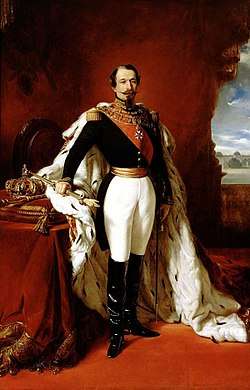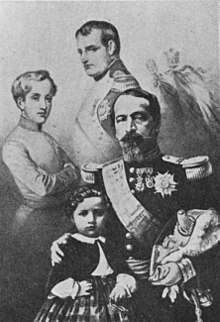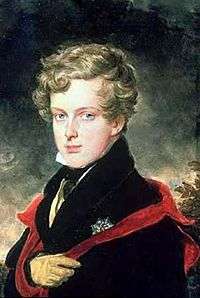Emperor of the French
| Emperor of the French | |
|---|---|
| Empereur des Français | |
|
Imperial | |
2.svg.png) | |
 | |
| Details | |
| Style | His Imperial Majesty |
| First monarch | Napoleon I |
| Last monarch | Napoleon III |
| Formation |
18 May 1804 2 December 1852 |
| Abolition |
22 June 1815 4 September 1870 |
| Residence | Tuileries Palace, Paris |
| Pretender(s) | Jean-Christophe Napoléon |

Emperor of the French (French: Empereur des Français) was the title used by the House of Bonaparte starting when Napoleon Bonaparte was given the title of Emperor on 18 May 1804 by the French Senate and was crowned emperor of the French on 2 December 1804 at the cathedral of Notre-Dame de Paris, in Paris, with the Crown of Napoleon.[1]
The title emphasized that the emperor ruled over "the French people" (the nation) and not over France (the republic). The old formula of "King of France" indicated that the king owned France as a personal possession. The new term indicated a constitutional monarchy.[2] The title was purposely created to preserve the appearance of the French Republic and to show that after the French Revolution, the feudal system was abandoned and a nation state was created, with equal citizens as the subjects of their emperor. (After 1 January 1809, the state was officially referred to as the French Empire.[3])
The title of "Emperor of the French" was supposed to demonstrate that Napoleon's coronation was not a restoration of monarchy, but an introduction of a new political system: the French Empire. Napoleon's reign lasted until 22 June 1815, when he was defeated at the Battle of Waterloo, exiled and imprisoned on the island of Saint Helena, where he died on 5 May 1821. His reign was interrupted by the Bourbon Restoration of 1814 and his own exile to Elba, from where he escaped less than a year later to reclaim the throne, reigning as Emperor for another 94 days before his defeat and final exile.
Less than a year after the French coup d'état of 1851 by Napoleon's nephew Louis-Napoléon Bonaparte, which ended in the successful dissolution of the French National Assembly, the Second French Republic was transformed into the Second French Empire, established by a referendum on 7 November 1852. President Louis-Napoléon Bonaparte, elected by the French people, officially became Napoleon III, Emperor of the French, from the symbolic and historic date of 2 December 1852. His reign continued until 4 September 1870, after he was captured at the Battle of Sedan during the Franco-Prussian War. He subsequently went into exile in England, where he died on 9 January 1873.
Since the early death in 1879 of Napoleon III's only son, Louis Napoléon, the House of Bonaparte has had a number of claimants to the French throne. The current claimant is Charles, Prince Napoléon, who became head of the House of Bonaparte on 3 May 1997. His position is challenged by his son, Jean-Christophe, Prince Napoléon, who was named as heir in his late grandfather's testament.
Full titles
The Emperors of the French had various titles and claims that reflected the geographic expanse and diversity of the lands ruled by the House of Bonaparte.
Napoleon I
His Imperial and Royal Majesty Napoleon I, By the Grace of God and the Constitution of the Republic, Emperor of the French, King of Italy, Protector of the Confederation of the Rhine, Mediator of the Swiss Confederation and Co-Prince of Andorra.
Napoleon II
His Imperial Majesty Napoleon II, By the Grace of God and the Constitution of the Republic, Emperor of the French and Co-Prince of Andorra.
Napoleon III
His Imperial Majesty Napoleon III, By the Grace of God and the will of the Nation, Emperor of the French and Co-Prince of Andorra.[4]
French Empire (1804–1814)
| Name | Lifespan | Reign start | Reign end | Notes | Family | Image |
|---|---|---|---|---|---|---|
Napoleon I
| 15 August 1769 – 5 May 1821 (aged 51) | 18 May 1804 | 11 April 1814 | — | Bonaparte |  |
French Empire (Hundred Days, 1815)
Regarded as a continuation of the First French Empire despite the brief exile of the Emperor Napoleon I
| Name | Lifespan | Reign start | Reign end | Notes | Family | Image |
|---|---|---|---|---|---|---|
Napoleon I
| 15 August 1769 – 5 May 1821 (aged 51) | 20 March 1815 | 22 June 1815 | — | Bonaparte |  |
| Napoleon II [5] | 20 March 1811 – 22 July 1832 (aged 21) | 22 June 1815 | 7 July 1815 | Son of Napoleon I | Bonaparte |  |
French Empire (1852–1870)
| Name | Lifespan | Reign start | Reign end | Notes | Family | Image |
|---|---|---|---|---|---|---|
| Napoleon III | 20 April 1808 – 9 January 1873 (aged 64) | 2 December 1852 | 4 September 1870 | Nephew of Napoleon I Cousin of Napoleon II | Bonaparte | .jpg) |
See also
References
- ↑ Thierry, Lentz. "The Proclamation of Empire by the Sénat Conservateur". napoleon.org. Fondation Napoléon. Retrieved 15 August 2014.
- ↑ Philip Dwyer, Citizen Emperor: Napoleon in Power (2013) p 129
- ↑ http://www.napoleon-series.org/research/government/legislation/c_republic.html
- ↑ http://www.heraldica.org/topics/france/napoleon.htm#naptitles
- ↑ From 22 June to 7 July 1815, Bonapartists considered Napoleon II as the legitimate heir to the throne, his father having abdicated in his favor. However, the young child's reign was entirely fictional, as he was residing in Austria with his mother. Louis XVIII was reinstalled as king on 7 July.